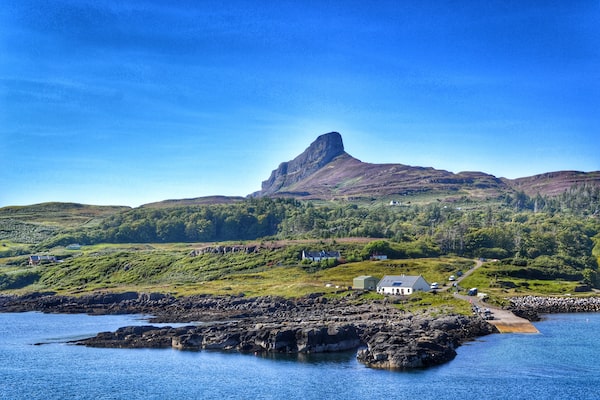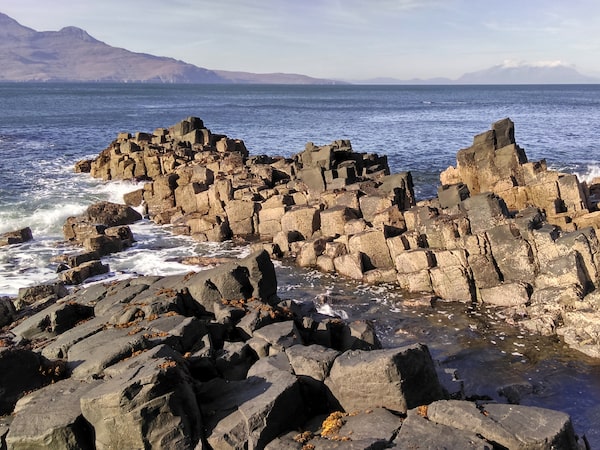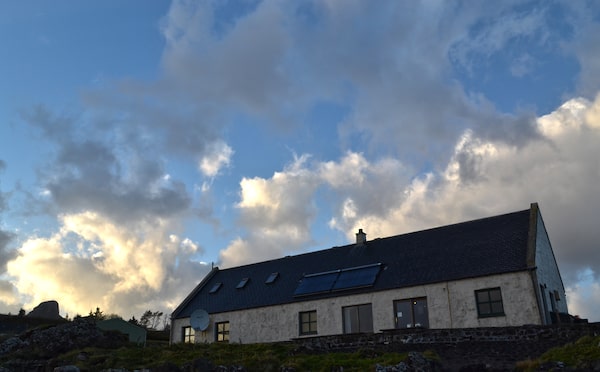
An Sgurr, a block of volcanic rock, dominates the island. The climb to the top brings you close to golden and sea eagles which have returned to the island, thanks to conservation efforts.Greg Carr
With rates of urbanization climbing year on year, you’d think there would be abandoned villages strewn about the wild countryside like so many Roman ruins. Not in the Scottish Hebrides. At least, not on a nine-kilometre heart-shaped island called Eigg.
It’s been 23 years since the local council, wildlife trust and five dozen residents formed a partnership to take ownership of Eigg from the unpopular, ineffective management of a former owner. The Isle of Eigg Heritage Trust built its own electric grid, powered by renewables, fitted residents’ homes with solar panels, built out the jetty, planted like mad.
In the intervening years, families proliferated and tourism flourished. A community centre emerged to marshal residents whose homes are kilometres apart. Employing 25 islanders, it was named An Laimhrig: “point of anchorage” or “safe harbour” in the local Scottish Gaelic. Community spirit has never been stronger.
Time well spent on London’s Greenwich Peninsula
This March, the island learned it would receive £100,000 ($175,000) to build a new An Laimhrig, to cope with the growing populace and some 11,000 annual visitors. According to Sam Foster, the architect of the new facility, the existing structure “has reached bursting point.”
Rather than kill opportunity on the island, decades of self-reliance have been a boon to Eigg (pronounced ‘egg’). Reducing its dependence on the sale of potatoes, kelp and wool, increased tourism has brought in entrepreneurs to rent out kayaks, catamarans and local cabins known as bothies.
The Wales Coastal Way offers drivers and walkers a captivating taste of wild Britain
A windswept, almost treeless volcanic island moored in the North Sea, Eigg is an hour’s ferry ride and five-hour train journey from Glasgow. It was once the sort of desolate, inhospitable place that couldn’t keep people. Decades of attrition during the last half of the 20th century left it with an aging population. The only newcomers were people running away from something: family, fast living, the shackles of cubicle life. Today, that desolation is its main selling proposition. Though livestock still outnumbers Eigg’s rosy-cheeked citizens by a large margin, the most recent birth brought the human population to 110 – still low, but 60 per cent higher than in 1997, the year of the buyout.
Birds of prey are making a comeback, too, including the elusive golden and sea eagles. To celebrate the 212 known species of birds on the island, this spring a creative network called Eigg Box will launch the inaugural Eigg Film Festival, with a focus on bird behaviour and migration. Plan a trip on either side of April 17 to 20, and you can help islanders celebrate their beloved jack snipes, twites and cuckoos in a white crofter’s cottage adapted for cinema-going.

Almost every island of the Hebrides has a place known as Pigeon's Cave, where birds alight and settle. There are 212 known bird species on Eigg, including jack snipes, twites and cuckoos.Greg Carr/Handout
Communal spaces are hard to come by on Eigg, which is why An Laimhrig’s overhaul is so crucial. The Galmisdale Bay Cafe, perched above the ferry dock alongside the welcome centre, represents a good portion of the island’s public buildings. The only other watering hole is the pub in Laig Bay, six kilometres away on the island’s only road. Plans drawn up by the architect Sam Foster include a new microbrewery. Without designated meeting points, the island’s celebrated tranquillity might prove too much for its full-time residents.
“I do not miss queues, traffic jams and traffic fumes, streetlights and all the noise you get on the mainland,” says Libby Galli, a felt artist from the south coast of England and a seven-year resident on Eigg. “The light is fantastic, very sharp and clear. We have amazing sunsets. And I’ve been lucky enough to see the Northern Lights. The scenery is so inspiring to the artists and craftspeople who live and work here.”
Following in the footsteps of ancient nobility in Britain’s Norfolk
Online arts and crafts marketplaces such as Etsy make it possible for artisans such as Galli to take their chances with extreme remote work, allowing them to supplement their income from local craft boutiques, such as the knitwear shop in the welcome centre.
In the aftermath of Brexit, when the idea of Scottish independence is once again gathering steam, it’s encouraging to observe people more reliant on their own decisions than any generated down in London.
Eigg’s current boom follows a long decline that began centuries ago. After passing between Norwegian and Gaelic leaders early in the last millennium (the island’s name is Norse for “sharp edge on a mountain”), the then-sizable community, several hundred strong, landed in the hands of the Scots. According to local legend, the resident Ranald clan had a beef with some neighbouring MacLeods, who lusted after their women. After being cast out from Eigg, the hawkish MacLeods returned and stalked the Ranalds to a cave, where the island’s entire population was hiding and burned them alive.

Artists are attracted to the area's spectacular sky and sunsets. At times, you can see the Northern Lights.Greg Carr
Today, when the entire island gets together, it’s for the summer ceilidh. Held every July, it concludes the annual Feis Eige festival, during which children learn the key-button accordion, fiddle, tin whistle and traditional dance. An island singing group gets together year-round and Galli and other local artists conduct workshops in felting and willow-weaving.
Still, it’s easy to escape to sandy beaches such as Laig that Galli says, “feel busy if they have 10 people on them.”
If you plan to visit, book well ahead. Of the island’s 60 properties, most are occupied full-time, year-round. That counts for a lot in today’s world of house-shares.
Food and drink
Restaurants on Eigg are scarce, though not non-existent. The café by the ferry terminal at Galmisdale Bay turns out a decent plate of fish and chips, and Laegorna Guest House, near Cleadale, does a three-course set evening menu for £30, with produce and proteins from the neighbouring islands.
If you’re travelling through Mallaig, on the mainland, pack a bag with sandwiches, pizzas and baked goods from the Bakehouse. The Cornerstone offers a seafood-heavy menu, including fresh local cod, mackerel, mussels and cullen skink: smoked-haddock soup. The Spar convenience store on Davies Brae stocks fresh fruit and veg, bread and snacks for the journey.
This is one of a four-part series sponsored by Visit Britain, which did not review or approve the story.
Get inspired by the weekly Sightseer newsletter, with travel advice, destinations and more. Sign up today.